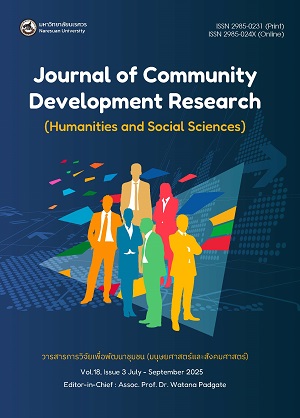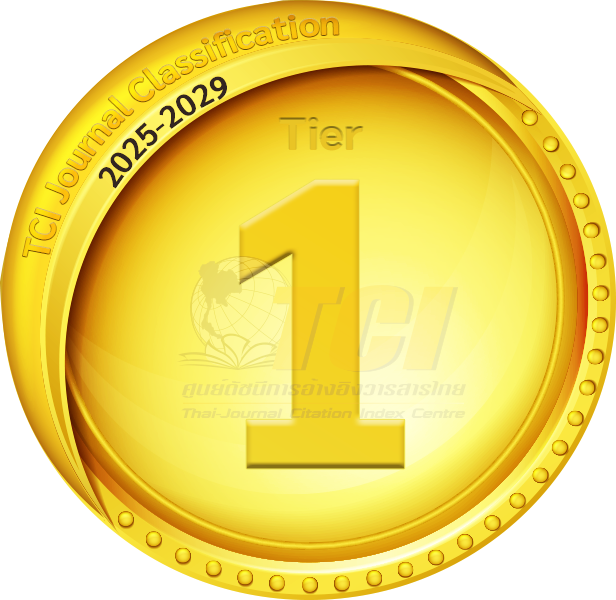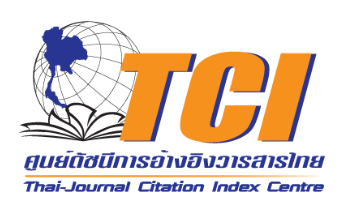Community Environmental Communicators’ Network Establishment and Communication Strategies: A Case of Chiang Mai Province
DOI:
https://doi.org/10.69650/jcdrhs.2025.1032Keywords:
Environmental Problem, Environmental Communication, Community Environmental Communicators’ Network, Participatory Communication, Chiang MaiAbstract
This applied research aimed to investigate the establishment of a community environmental communicators’ network in Chiang Mai Province and examine the communication strategies employed to foster collaboration within the network. Based on qualitative case studies, the research employed in-depth interviews and participatory observation focusing on four key environmental issues: ecotourism (Chiang Dao District), waste and wastewater management (Mueang Chiang Mai District), expansion of green space in urban areas (San Kamphaeng District), and sustainable agriculture (San Sai District). Grounded in participatory environmental communication theory which emphasized the empowerment of local stakeholders, inclusive dialogue, and community-led action, the findings revealed that Prachatham Media Foundation played a central coordinating role in initiating and supporting the network. The foundation facilitated the formation of the network through issue-based analysis, alliance building, and the development of proactive local communicators. These efforts enabled community members not only to participate in environmental communication but also to shape the agenda and strategies themselves. This finding also affirmed the use of three key communication strategies in establishing the network: 1) creating content grounded in core data and contextual linkage, 2) horizontal communication, and 3) participatory media. The study underscored the importance of cross-sector collaboration, including support from government agencies, business operators, external partnership networks and young audiences, for developing communication competencies and sustaining the network’s long-term activities. Ultimately, this research contributed to the theoretical understanding and practical application of participatory environmental communication. It highlighted how localized, collaborative communication network could empower communities and serve as a bottom-up mechanism for advancing sustainable environmental solutions and informing broader policy development.
References
Baengthit, R., & Benjasilarak, N. (2022). Environment, Media, and Citizen. Chiang Mai: Prachatham Media Foundation. Retrieved from https://prachatham.com/ebook03/
Boykoff, M. T., & Boykoff, J. M. (2007). Climate Change and Journalistic Norms: A Case-study of US Mass-media Coverage. Geoforum, 38(6), 1190-1204. https://doi.org/10.1016/j.geoforum.2007.01.008
Chiang Mai Provincial Office. (2024). Chiang Mai Provincial Development Plan 2023-2027 (Reviewed Edition 2024). Retrieved from http://www.chiangmai.go.th/web2563/strategy/
Chongkolrattanaporn, T. (2009). Global Warming in Bangkok: Environmental Network Communication. Journal of Language and Culture, 28(2), 5-24. Retrieved from https://so03.tci-thaijo.org/index.php/JLC/article/view/20208
Cox, R. (2013). Environmental Communication and the Public Sphere (3rd ed). Thousand Oaks, California: SAGE Publications.
Flor, A. G. (2004). Environmental Communication: Principles, Approaches and Strategies of Communication Applied to Environmental Management. Philippines: UP Open University.
Harris, U. S. (2017). Engaging Communities in Environmental Communication. Pacific Journalism Review: Te Koakoa, 23(1), 65-79. https://doi.org/10.24135/pjr.v23i1.211
Harris, U. S. (2019). Participatory Media in Environmental Communication: Engaging Communities in the Periphery. New York, NY: Routledge.
Kaeochada, T. (2014). Communication Management for Eliminating Environmental Problem in Khlong Saen Saep and Perceiving’s Masjid Kamalulislam Community (Master’s Thesis). Graduate School of Communication Arts and Management Innovation, National Institute of Development Administration, Bangkok. Retrieved from https://repository.nida.ac.th/items/257e6747-2d68-4c17-8dfb-2072e5acbdb5
Kaewthep, K. (2006). Communication for a Beautiful World: Lessons from Environmental Management Communication in Communities. Bangkok: The Thailand Research Fund.
Kheerajit, C., & Flor, A. G. (2013). Participatory Development Communication for Natural Resources Management in Ratchaburi Province, Thailand. Procedia - Social and Behavioral Sciences, 103, 703-709. https://doi.org/10.1016/j.sbspro.2013.10.390
Pezzullo, P. C., & Cox, R. (2018). Environmental Communication and the Public Sphere (5th ed.). Los Angeles, California: SAGE Publications.
Phuengsamran, P., Sotwitee, S., Leeruksatial, P., & Kakhaikittawat, T. (2019). Strategic Communications on Public Issues: Approaches to Restoration Conservation and Sustainable Benefit Utilization: A Case Study of Blue Swimming Crab Sustainability Project in Kung Krabaen Bay Royal Development Study Center. Journal of Business, Economics and Communications, 14(2), 79-93. Retrieved from https://so02.tci-thaijo.org/index.php/BECJournal/article/view/129408
Piyasatittham, G. (2013). Communication Process for Thai Sea Conservation Through SOS Website (Master’s Thesis). Faculty of Journalism and Mass Communication, Thammasat University, Bangkok. Retrieved from https://digital.library.tu.ac.th/tu_dc/frontend/Info/item/dc:103470
Roonkaseam, N., Janjamsai, M., & Sompuech, P. (2019). A Development of Communication Competency for Canal-community Communicators. Academic Journal of Humanities and Social Sciences Burapha University, 27(53), 65-86. Retrieved from https://so06.tci-thaijo.org/index.php/husojournal/article/view/128969
Sitthisuntikul, K., Paiboonwatanakit, P., & Charoenkul, G. (2019). Communication for Participatory Environmental Development in Chiang Mai City: The Project of Spark U, the Actions for Urban Change in Chiang Mai, the North of Thailand. Recent Science and Technology, 11(2), 290–301. Retrieved from https://li01.tci-thaijo.org/index.php/rmutsvrj/article/view/205018
Suansida, R. (2016). The Development of Communication Process for Sustainable Conservation in Muak Lek Tributary. Journal of Research and Development, Buriram Rajabhat University, 11(Special), 183-189. Retrieved from https://so03.tci-thaijo.org/index.php/RDIBRU/article/view/130430/
Suchitta, S., Sridee, S., & Tokeaw, W. (2023). Communication for Participation in Creating Successful Waste Management by Communities. Journal of Multidisciplinary in Social Sciences, 19(3), 48-54. Retrieved from https://so03.tci-thaijo.org/index.php/sduhs/article/view/274232
Vejjanukroh, K. (2013). The Communication for Developing Social Participation: The Study of Eco-tourism Management of Khlongkhon, Samutsongkhram (Master’s Thesis). Faculty of Journalism and Mass Communication, Thammasat University, Bangkok. Retrieved from https://digital.library.tu.ac.th/tu_dc/frontend/Info/item/dc:100388
Wannaudom, P. (2019). The Creation of Communication in the Community to Implement the Environmental Rehabilitation Strategy from Use Chemicals for Agriculture in Loei Province. Journal of Management Science Chiangrai Rajabhat University, 14(2), 206-241. Retrieved from https://so03.tci-thaijo.org/index.php/jmscrru/article/view/228417/
Yasir, Y., Firdaus, M., Nurjanah, N., & Salam, N. E. (2021). Environmental Communication Model through Community-based Tourism Development in Overcoming Mangrove Damage. In IOP Conference Series: Earth and Environmental Science, Volume 886, 2nd Biennial Conference of Tropical Biodiversity, Makassar, Indonesia, August 4-5, 2021. https://doi.org/10.1088/1755-1315/886/1/012022
Downloads
Published
How to Cite
Issue
Section
License
Copyright (c) 2025 Journal of Community Development Research (Humanities and Social Sciences)

This work is licensed under a Creative Commons Attribution 4.0 International License.









